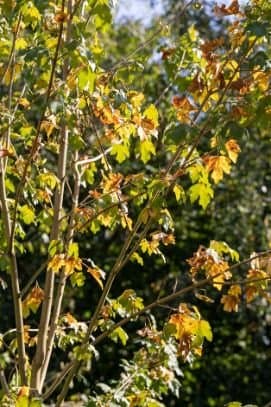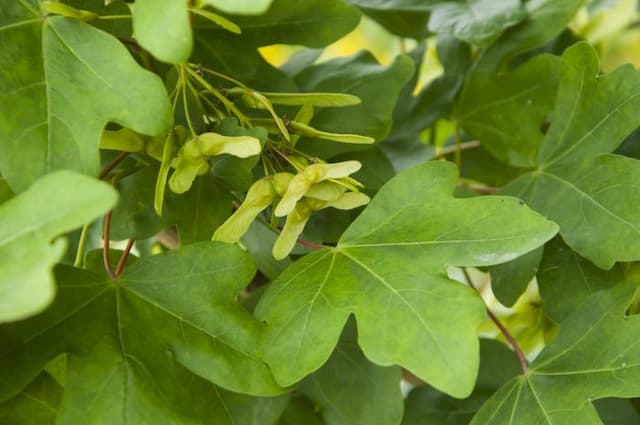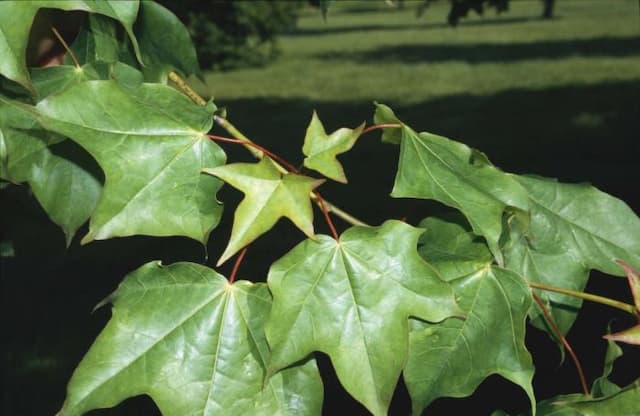Japanese Maple Acer palmatum 'Twombly's Red Sentinel'
ABOUT
The 'Twombly's Red Sentinel' Japanese maple is a plant with a distinct appearance characterized by its vibrant foliage and elegant form. The leaves of this variety have a unique shape, resembling hands with outstretched fingers, typically with five to seven pointed lobes. In spring, the foliage emerges in brilliant shades of red, which is quite eye-catching and adds a burst of color to any garden. As the seasons change, the leaves transition to a deeper, rich crimson color, providing a striking contrast against the landscape throughout the summer. In the fall, the foliage may turn even more intense hues of red before the leaves drop, a dazzling display that makes the 'Twombly's Red Sentinel' a favorite among gardeners seeking a tree with year-round visual interest. Beyond its colorful leaves, the structure of the plant is also noteworthy. It has a dense, upright growth habit, forming a columnar shape that gives it an elegant and stately presence. The branches gently cascade, making it a perfect specimen for adding height and vertical interest without taking up too much horizontal space. The bark on the young branches has a smooth texture and a color that can range from green to red, complementing the foliage. As the tree matures, the bark may develop a slightly rougher texture, adding character to its appearance. Overall, the 'Twombly's Red Sentinel' Japanese maple is revered for its stunning leaf color and graceful architectural form, which makes it an exceptional choice for adding a touch of drama and sophistication to gardens.
About this plant
 Names
NamesFamily
Sapindaceae
Synonyms
Twombly's Red Sentinel Japanese Maple, Red Sentinel Japanese Maple
Common names
Acer palmatum 'Twombly's Red Sentinel'.
 Toxicity
ToxicityTo humans
The Japanese Maple is generally considered non-toxic to humans, and there are no widely recognized symptoms of poisoning from ingestion of this plant. However, as with any plant, individual sensitivities can occur, and it's always advisable not to consume parts of ornamental plants due to potential unforeseen reactions or the possible presence of garden chemicals.
To pets
The Japanese Maple is not known to be toxic to pets. There should generally be no symptoms of poisoning in pets that consume parts of this tree. However, ingestion of large quantities of any non-food plant can potentially cause mild stomach upset in some pets due to the fibrous plant material. If a pet consumes a significant amount of the plant and shows signs of distress, it is best to consult a veterinarian.
 Characteristics
CharacteristicsLife cycle
Perennials
Foliage type
Deciduous
Color of leaves
Red
Height
10 feet (3 meters)
Spread
5 feet (1.5 meters)
Plant type
Tree
Hardiness zones
5
Native area
Japan
Benefits
 General Benefits
General Benefits- Ornamental Appeal: Japanese Maple features a striking red foliage that adds color and decorative flair to any garden.
- Compact Size: 'Twombly's Red Sentinel' has a narrow, upright growth habit, making it suitable for smaller spaces.
- Seasonal Interest: This cultivar provides year-round interest with its colorful leaves, which change hues from spring through fall, and its attractive winter silhouette.
- Shade Tolerance: Can thrive in a variety of light conditions, including partial shade, where other plants may struggle.
- Low Maintenance: Requires minimal pruning and care once established, making it an ideal choice for gardeners of all skill levels.
- Drought Tolerance: Once established, it can withstand periods of dry conditions, reducing the need for frequent watering.
- Cold Hardiness: Capable of surviving in cooler climates, which makes it versatile for different garden zones.
 Medical Properties
Medical PropertiesThis plant is not used for medical purposes.
 Air-purifying Qualities
Air-purifying QualitiesThis plant is not specifically known for air purifying qualities.
 Other Uses
Other Uses- Acer palmatum 'Twombly's Red Sentinel', commonly known as Japanese Maple, can be trained into a bonsai tree for an intricate and miniature display of its beauty.
- The wood of the Japanese Maple is sometimes used in the creation of musical instruments, such as the bodies of flutes, due to its fine grain and workability.
- This plant's branches can be used in floral arrangements, adding a striking red hue to complement flowers and other foliage.
- The leaves can be pressed and used in crafting, for instance, in making decorative bookmarks or in scrapbooking projects.
- Dried Japanese Maple leaves can be incorporated into a natural potpourri mix, offering an aesthetic element with their rich color.
- An extract from the bark can be used as a natural dye for textiles, giving fabrics a soft, reddish-brown tint.
- Leaves of the Japanese Maple, when conditioned properly, can be transformed into leaf skeletons for use in art projects, revealing a delicate vein structure.
- The strong, yet flexible wood may be used for making small wooden objects such as picture frames or intricately carved boxes.
- The annual growth layer patterns of the wood make it a useful tool in dendrochronology (the study of dating and interpreting tree rings) for educational purposes.
- Juvenile stems can be harvested and woven or bent to create natural garden structures, such as trellises or fences, that blend seamlessly with the landscape.
Interesting Facts
 Feng Shui
Feng ShuiThe Japanese Maple, particularly 'Twombly's Red Sentinel', can be used in Feng Shui to enhance positive energy in a garden. Its red foliage is associated with the Fire element, which can energize and bring life to an area. Planting a Japanese Maple in the East can promote health and family harmony, while positioning it in the Southeast can foster wealth and abundance. Be sure to maintain the tree well to ensure it adds to the positive chi in your space.
 Zodiac Sign Compitability
Zodiac Sign CompitabilityThe Japanese Maple is not used in astrology practice.
 Plant Symbolism
Plant Symbolism- Peace: The Japanese maple, as a species, is often associated with peace due to its serene and delicate appearance, representing a calming presence.
- Beauty and Elegance: This cultivar, with its red leaves, is particularly valued for its ornamental beauty and the elegant shape of its foliage.
- Balance: The branching patterns and bilateral symmetry of the tree can symbolize balance and harmony within one's life.
- Endurance and Change: As a deciduous tree that changes color and sheds its leaves, it represents the ability to endure changes and emerge gracefully from transitions.
- Great Blessings: In Japan, the maple tree is often associated with blessings and is celebrated during the autumn season.
 Water
WaterThe Japanese Maple 'Twombly's Red Sentinel' prefers consistently moist but not waterlogged soil. Water the plant deeply once or twice a week, depending on the weather conditions, and more frequently during dry spells. Each watering session should involve slowly adding 10 to 15 gallons of water to allow deep soil penetration, promoting healthier root development. Always check the soil moisture level before watering; it should be damp but not soggy. During the winter months, reduce the watering frequency as the plant's water needs decrease.
 Light
LightJapanese Maple 'Twombly's Red Sentinel' thrives in a location that offers full sun to partial shade. It performs best when it receives morning sunlight and is protected from the harsh afternoon sun, especially in hotter climates. A spot that provides a mix of sunlight and light dappled shade throughout the day is ideal for the vibrant foliage to develop its full color potential.
 Temperature
TemperatureJapanese Maple 'Twombly's Red Sentinel' can endure temperatures as low as 20 degrees Fahrenheit but should be protected from harsh winter winds. The ideal temperature range for this plant is between 60 and 80 degrees Fahrenheit. While it can survive a brief period of heat above 90 degrees Fahrenheit, prolonged exposure to high temperatures may stress the plant.
 Pruning
PruningPrune the Japanese Maple 'Twombly's Red Sentinel' to maintain its shape and remove any dead or diseased branches. The best time for pruning is late winter or early spring before new growth begins. Occasional thinning of the canopy helps promote better air circulation and light penetration, which is beneficial for the tree's health. Prune sparingly, as excessive pruning can stimulate unwanted growth and weaken the tree.
 Cleaning
CleaningAs needed
 Soil
SoilThe Japanese Maple prefers a moist, well-draining soil mix with good organic content. A combination of loamy garden soil, peat moss, and perlite or pine bark is ideal. Aim for a soil pH between 5.5 and 6.5 for optimal growth.
 Repotting
RepottingJapanese Maples, including 'Twombly's Red Sentinel', generally require repotting every 2-3 years when young or when roots become pot-bound. Mature trees may be repotted less frequently, about every 4-5 years.
 Humidity & Misting
Humidity & Misting'Twombly's Red Sentinel' Japanese Maple thrives in moderate humidity levels. While specific humidity requirements are not stringent, avoiding extremely dry conditions is beneficial for the health of the tree.
 Suitable locations
Suitable locationsIndoor
Ensure bright indirect light, avoid dry heat, and protect from drafts.
Outdoor
Place in dappled shade, shelter from strong winds and extreme cold.
Hardiness zone
5-8 USDA
 Life cycle
Life cycleJapanese Maple 'Twombly's Red Sentinel' begins its life cycle as a seed, which after stratification, germinates in the spring. These germinated seeds develop into seedlings with characteristic lobed leaves that exhibit their signature red color. As the seedling grows, it enters a juvenile phase, with rapid growth and formative branching, until it reaches maturity in several years. Upon maturity, the Japanese Maple 'Twombly's Red Sentinel' achieves its upright, narrow growth habit and begins its reproductive cycle by producing small, inconspicuous flowers followed by samaras, the winged seeds typical of maples. The tree will continue to experience seasonal cycles of growth and dormancy, with foliage turning vivid red to purple in the autumn before leaf drop. With proper care, 'Twombly's Red Sentinel' can live for several decades, during which it will continue to reproduce and potentially produce new saplings.
 Propogation
PropogationPropogation time
Early Spring
The Acer palmatum 'Twombly's Red Sentinel', commonly known as Japanese maple, is often propagated through grafting, which is the most popular method for this variety to ensure the offspring retain the same characteristics as the parent plant. Grafting usually takes place in late winter when the plant is still dormant. A piece of a stem, known as a scion, from the 'Twombly's Red Sentinel' is joined to a section of a rootstock that comes from a seedling or a different but related maple variety. The scion, which contains a bud, is carefully cut at an angle and joined to a corresponding cut in the rootstock. The two pieces are then secured together with grafting tape or a similar material and left to heal and fuse over several weeks, during which the graft should be kept in a humid environment to prevent drying out.







![Freeman maple [Autumn Blaze]](/_next/image?url=https%3A%2F%2Fplants-admin.emdemapps.com%2Fimages%2Fplants%2F%2Fimages%2F604b575b84d87.png&w=640&q=75)

